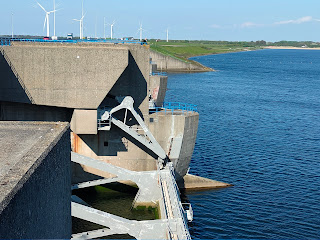We could not believe it. Our last day in Holland had arrived. Once again the sky was cloudless although the northerly breeze kept us cool enough to ride comfortably so after waving goodbye to our hosts for the night we set off towards the ferry port. The last few days had taken a lot out of us so in some ways we were looking forward to getting on board our ship and settling in for a good night's rest during the overnight passage. But in other ways we were sad to be leaving a place where we had enjoyed such an amazing holiday. (I was going to say relaxing, a strange thing to feel after riding so many kilometres.) As it turned out we had decided that the direct route to the ferry port would not be enough for us and whilst planning the ride the previous evening we decided to make a small detour to visit a vegetarian restaurant, of all things, that would make a good stopping point for lunch. It was actually run by an Italian couple who made their own very tasty houmous. Well worth the detour.
An early arrival at the ferry dock meant we were able to get ourselves and our bikes on board quite quickly, lash them down, then take the lift up to our cabin four decks above. Loading so many cars and other vehicles is a complicated and slow business and getting on board early meant that we could look down smugly upon those still waiting down below on the dock. Sitting in a car might be comfortable enough and foot passengers can wait indoors but if you are a cyclist and it is raining or cold then this is not where you would want to be hanging about.Finally the moment came to push our bikes off the ferry and take to the road to cycle away from the port. This time, however, we were back in the UK, so we had to remember to cycle on the left side of the road and also to steer to the left when confronted by another cyclist on a cycle path. Even more important was to remember to look to the right to check for cars when crossing a road. Everything that had become instinctive during the last month had to be un-learnt...and urgently, from the moment our feet touched British soil. And once again we faced the complex journey from port to home which started with a bike ride from the ferry terminal to Newcastle Central Station, right in the centre of the city. Fortunately this starts with a properly signposted cycle path so with all our senses on full alert we jumped onto our bikes and rode off.
We soon found ourselves crossing a waterway, just like we had done many times in Holland, although we could not help but notice something rather different in what we were seeing. Similarly with the cycle path itself which, instead of being smooth and clean, was riddled with lumps and bumps, obstacles that we had to steer around carefully. It was also covered with rubbish and dog poo plus we were constantly ducking from the overhanging tree and bramble branches that were growing beside the path. When we came to our first road crossing it became clear that priority would be given to cars, cyclists always being expected to give way even on the smallest of roads. This was not what we had become used to. It occurred to us that in the UK there are no rules embedded in our Highway Code that can be applied to signify a change of priority at junctions, no road markings specifically designed to indicate that cyclists have priority. All road users, cars included, are expected to give way at a Zebra crossing, marked with broad white lines on the road, but there is nothing similar to deal with the situation where a cycle path crosses a road. There might be an awkward pair of iron fences on the path which cyclists have to zigzag around when approaching a road but sometimes these are absent so there is nothing to warn the cyclist of the approaching road crossing and certainly never anything to require a car driver to give way. We had become used to a vastly different infrastructure everywhere we went in Holland, irrespective of whether it was a town or in the country. We had now arrived back in a country where cyclists are treated as less important than any other road user, quite a scary place to be.
Several times we were directed onto minor roads, perhaps through a housing estate, and the unclear signposting made this quite difficult but eventually the Hadrian's Wall cycle path took us along the River Tyne to the quayside in the centre of Newcastle. From this point we were faced with a very steep climb uphill to the station, this being on overcrowded roads with no signposted guidance as to which route to follow. It might have been safer to walk the bikes but pushing a loaded bike uphill either in the road or on the pavement is extremely strenuous. In the end we did a bit of both, riding, juggling with the traffic, and pushing, until the station finally came into view.

























